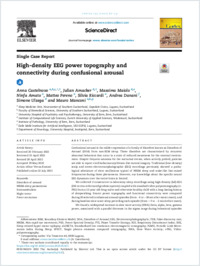High-density EEG power topography and connectivity during confusional arousal
- Castelnovo, Anna ORCID Sleep Medicine Unit, Neurocenter of Southern Switzerland, Ospedale Civico, Lugano, Switzerland ; Faculty of Biomedical Sciences, Università della Svizzera italiana, Switzerland ; University Hospital of Psychiatry and Psychotherapy, University of Bern, Bern, Switzerland
- Amacker, Julian Institute of Computational Life Sciences, Zurich University of Applied Sciences, W€adenswil, Switzerland
- Maiolo, Massimo Institute of Computational Life Sciences, Zurich University of Applied Sciences, W€adenswil, Switzerland ; Institute of Pathology, University of Bern, Bern, Switzerland
- Amato, Ninfa Sleep Medicine Unit, Neurocenter of Southern Switzerland, Ospedale Civico, Lugano, Switzerland
- Pereno, Matteo Sleep Medicine Unit, Neurocenter of Southern Switzerland, Ospedale Civico, Lugano, Switzerland
- Riccardi, Silvia Sleep Medicine Unit, Neurocenter of Southern Switzerland, Ospedale Civico, Lugano, Switzerland
- Danani, Andrea ORCID Istituto Dalle Molle di studi sull'intelligenza artificiale (IDSIA), Facoltà di scienze informatiche, Università della Svizzera italiana, Svizzera
- Ulzega, Simone Institute of Computational Life Sciences, Zurich University of Applied Sciences, W€adenswil, Switzerland
- Manconi, Marco ORCID Sleep Medicine Unit, Neurocenter of Southern Switzerland, Ospedale Civico, Lugano, Switzerland ; Faculty of Biomedical Sciences, Università della Svizzera italiana, Switzerland ; Department of Neurology, University Hospital, Inselspital, Bern, Switzerland
- 2022
Published in:
- Cortex. - 2022, vol. 155, p. 62-74
English
Confusional arousal is the milder expression of a family of disorders known as Disorders of Arousal (DOA) from non-REM sleep. These disorders are characterized by recurrent abnormal behaviors that occur in a state of reduced awareness for the external environment. Despite frequent amnesia for the nocturnal events, when actively probed, patients are able to report vivid hallucinatory/dream-like mental imagery. Traditional (low-density) scalp and stereo-electroencephalographic (EEG) recordings previously showed a pathological admixture of slow oscillations typical of NREM sleep and wake-like fast-mixed frequencies during these phenomena. However, our knowledge about the specific neural EEG dynamics over the entire brain is limited.
We collected 2 consecutive in-laboratory sleep recordings using high-density (hd)-EEG (256 vertex-referenced geodesic system) coupled with standard video-polysomnography (v-PSG) from a 12-year-old drug-naıve and otherwise healthy child with a long-lasting history of sleepwalking. Source power topography and functional connectivity were computed during 20 selected confusional arousal episodes (from -6 to + 18 sec after motor onset), and during baseline slow wave sleep preceding each episode (from -3 to -2 min before onset).
We found a widespread increase in slow wave activity (SWA) theta, alpha, beta, gamma power, associated with a parallel decrease in the sigma range during behavioral episodes compared to baseline sleep. Bilateral Broadman area 7 and right Broadman areas 39 and 40 were relatively spared by the massive increase in SWA power. Functional SWA connectivity analysis revealed a drastic increase in the number and complexity of connections from baseline sleep to full-blown episodes, that mainly involved an increased out-flow from bilateral frontomedial prefrontal cortex and left temporal lobe to other cortical regions. These effects could be appreciated in the 6 sec window preceding behavioral onset.
Overall, our results support the idea that DOA are the expression of peculiar brain states, compatible with a partial re-emergence of consciousness.
We collected 2 consecutive in-laboratory sleep recordings using high-density (hd)-EEG (256 vertex-referenced geodesic system) coupled with standard video-polysomnography (v-PSG) from a 12-year-old drug-naıve and otherwise healthy child with a long-lasting history of sleepwalking. Source power topography and functional connectivity were computed during 20 selected confusional arousal episodes (from -6 to + 18 sec after motor onset), and during baseline slow wave sleep preceding each episode (from -3 to -2 min before onset).
We found a widespread increase in slow wave activity (SWA) theta, alpha, beta, gamma power, associated with a parallel decrease in the sigma range during behavioral episodes compared to baseline sleep. Bilateral Broadman area 7 and right Broadman areas 39 and 40 were relatively spared by the massive increase in SWA power. Functional SWA connectivity analysis revealed a drastic increase in the number and complexity of connections from baseline sleep to full-blown episodes, that mainly involved an increased out-flow from bilateral frontomedial prefrontal cortex and left temporal lobe to other cortical regions. These effects could be appreciated in the 6 sec window preceding behavioral onset.
Overall, our results support the idea that DOA are the expression of peculiar brain states, compatible with a partial re-emergence of consciousness.
- Collections
- Language
-
- English
- Classification
- Medicine
- License
- Open access status
- hybrid
- Identifiers
-
- DOI 10.1016/j.cortex.2022.05.021
- ARK ark:/12658/srd1324957
- Persistent URL
- https://n2t.net/ark:/12658/srd1324957
Statistics
Document views: 94
File downloads:
- Castelnovo_2022_Else_cortex: 197
